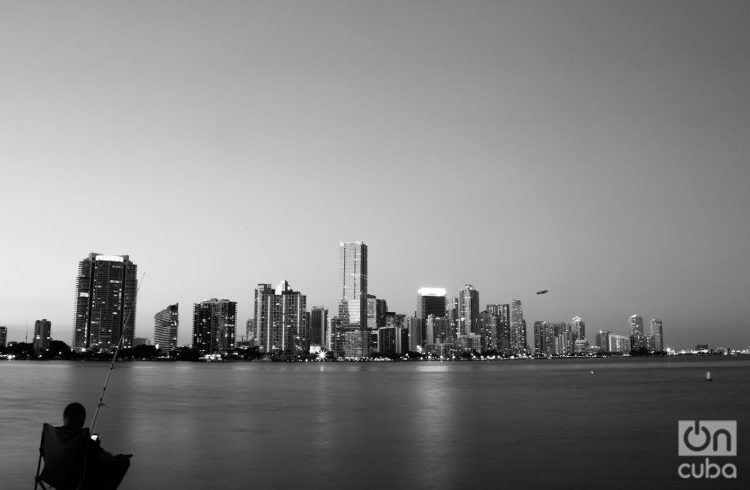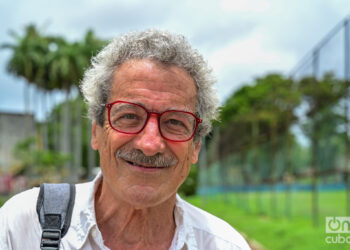In the mid-1990s a young Cuban academician landed for the first time in Miami. That same day a friend picked him up for a tour of the city: from Calle 8 to the Chapel of Our Lady of Charity. When entering a shop, all of a sudden he saw a sign on the shop window: ENGLISH SPOKEN. His first reaction was not verbal but rather gestural, a quick glance at his friend and classmate, one of those looks with wide-open eyes. Wasn’t it supposed to be the other way around? Where were we? Sometime later, continuing what is called the process of cultural immersion, he ran into other realities. In Miami people didn’t return your call but rather llamaban pa’ atrás; they di not pay bills, but rather biles; the ACs and the faucets did not leak, but rather liqueaban; they did not file a lawsuit, but rather a sue, something that language experts call loans, one of the results of the contact between two cultural bodies that had already culminated in Spanglish, to which the Puerto Ricans from New York and the Chicanos from New Mexico had sufficiently contributed.
But the young man also witnessed other processes. Two of his second cousins, born in Miami, spoke Spanish with their parents and grandparents in their Kendall home, but English among themselves. On the following day they took him to Lincoln Road to dine in a restaurant called Yuca (Young Urban Cuban-American). Another second cousin – born in Miami, an FIU (Florida International University) graduate, who knew what no one knew about the Muñequitos de Matanzas without having ever traveled to the island, and that in his conversation might use the same words/expressions of any Havana marginal – gave him a copy of a magazine called Generation Ñ – the latter, as is well known, being a letter absent in the English alphabet.
These experiences encouraged in the young academician the interest in these and other sociocultural problems on the other side of the Strait, and especially in Miami. The first was identifying a reality that not always comes to the surface: the fact that Cubans had arrived there after other émigré/minority communities. In effect, an until-then unprecedented phenomenon had started emerging between the late 1970s and the mid-1980s: bilingualism. We are speaking, in this case, of a human group descendants from the historic exile, who arrived in the United States when they were children/adolescents and who vindicated for themselves the category of Cuban-Americans, in a similar sense as to what had already occurred with other groups that emigrated to the Union – let’s say the Italians, the Irish and the Asians -, among whom the awareness of a diverse identity (or more exactly identities) already formed part of the so-called melting pot, as Brazilian sociologist Darcy Ribeiro at one point called “transplanted peoples,” that is to say, formed based on a strong, dissimilar and sustained migration component.
This process of assimilation involved, somehow, de-exiling and taking root in the receiving culture, frequently based on unions – marital or otherwise – with U.S. men or women, or with other Latinos. And the historic exiles had not arrived for that, but rather to return as quickly as possible, although due to pure pragmatism they founded a bilingual school in Coral Gables to make it easier for their children to have good command of English and Spanish while everything returned to normal.
Since literature has some cognitive value, the young man then had to resort to it. Bilingualism had its first expression in the anthology Los atrevidos (1988), by Carolina Hospital, texts by a group of persons who had been born on the island in the 1960s and who lived in the United States and had ventured to write in English for the first time. Testimonies like Little Havana Blues (1996), by Virgil Suárez and Delia López, a selection of 32 authors who wrote in English, would come later. That generation, called 1.5 (located midway between their culture of birth and that of the receiving society), would be reflected on a theoretical level in the seminal essay by Gustavo Pérez Firmat (The Cuban Condition. Translation and Identity in Modern Cuban Literature [1989], Life on the Hyphen. The Cuban-American Way [1994]), which frequently underwent a discussion, among other things for obviating determinations like gender, race and sexual orientation.
Here the distinctive consists, in effect, in the bicultural condition, that is, moving between two systems of idiomatic-cultural references. The category alluded to had widespread reception in literary studies, starting with academic researches that today are already classics like that of Isabel Álvarez Borland, Cuban-American Literature of Exile. From Person to Persona (1998), which told about a phenomenon also new until then: the boom of Cuban-American writers of the 1990s, embodied in the works of Pablo Medina (1948), Roberto G. Fernández (1951), Oscar Hijuelos (1951-2013), Achy Obejas (1956), Cristina García (1958), Virgil Suárez (1962) and the very Pérez Firmat (1949), among others, and which cannot be fully understood if the receiving society’s context is not taken into account, that is to say, the Hispanic/Latino presence and its impact on the cultural industries, including the literature printed by publishing houses like Arte Público Press and others that, in their catalogs, started increasingly incorporating what they called ethnic writers. The Cuban was but a specific chapter of that same phenomenon.
As the years went by, the young apprentice of academician was able to start answering, in some way, those (and other) initial concerns, always aware that it was a slippery field due to its multiple and complex determinations. However, meanwhile other new concerns emerged. What would happen, for example, with the children of his second cousins? Would they renounce Cervantes? Was Spanish losing ground in Miami, something that according to experts and academicians is already happening in the entire nation, except for the entry of new emigrants from Latin America? Being the leader, at some point would Miami be behind Los Angeles, Riverside and Dallas, where the most Spanish is spoken in the entire Union? And to continue along the same line: What would be the role of bilingual education in the schools? What factors would decide over this? What problems would emerge? And the so-called “point of inflexion”: would the close to 125 million Hispanics/Latinos in 2055 then be, from the perspective view of the language, more or less “dust in the wind,” like in that old tune by the Kansas?
Neither are there univocal answers to these questions, fully valid and up to date. But a sociolinguist of the area has noted, with reason, the following: “Miami is a very special city in the United States with respect to Spanish, because we find people with a high and a low socioeconomic level who speak Spanish. It’s very different, for example, from Los Angeles, because the immigrants or the working class are the ones who speak Spanish.” Meanwhile, a local study revealed that, in the labor market, speaking both languages means an average additional income of some 7,000 dollars a year.
Keeping this in mind, something seems ensured. To say it with Borges words: there will be a garden of paths that bifurcate, but it will be very difficult to give Spanish a death certificate in Miami. A famous Chilean folklorist would perhaps put it another way: it started “tangling up, tangling like the musk in the ivy.”










